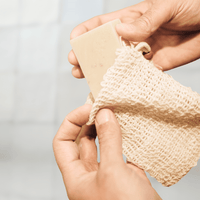
As the seasons change, so do the needs of your skin. Dry skin can be a real bother but there are eco-friendly ways and natural methods to keep your skin happy and hydrated.
Dry Skin During Seasonal Changes
Dry skin during seasonal changes is a common issue. Here are several reasons why it occurs:
- Low humidity: The air often becomes drier during the transition from warm to colder seasons, like summer to autumn or winter. Low humidity levels can lead to increased water loss from your skin, causing it to feel dry and tight.
- Cold weather: Cold air has less moisture content and exposure to it can reduce your skin's ability to retain moisture. Cold winds can strip away the natural oils that are a proactive barrier on your skin.
- Indoor heating: When the weather turns cold, people often use indoor heating systems which can further reduce the humidity indoors, creating a harsh environment on the skin.
- Hot showers and baths: While they may be tempting in cold weather, hot showers and baths can strip your skin's natural oils, leading to dryness.
- Changes in skincare: You may not adjust your skincare routines to account for the changing climate. Using products suitable for humid summer weather may need to provide more moisture in dry, cold conditions.
- Lack of sun exposure: Sun exposure can stimulate the production of vitamin D essential for skin health. During colder seasons, you may spend less time outdoors which can affect vitamin D levels, potentially contributing to your dry skin.
Identifying Dry Skin
Identifying dry skin is relatively straightforward as it often presents noticeable signs and symptoms. Here's how to determine if you have dry skin:
- Texture and feel: Dry skin typically feels tight and rough and may even appear flaky. When you touch it, it might lack smoothness and suppleness. Your skin may feel "thirsty" or as if it needs moisture.
- Flakiness: One of the most common signs of dry skin is flakiness. You might notice small, dry skin flakes, especially on your cheeks, forehead or other dry-prone areas.
- Redness and irritation: Your skin can sometimes be accompanied by redness and irritation. This is because the skin's protective barrier is compromised, making it more susceptible to external irritants.
- Itchiness: Your skin often feels itchy. It could be a sign of dry skin if you find yourself frequently scratching or experiencing discomfort due to itchiness.
- Fine lines and wrinkles: Dry skin shows signs of aging such as fine lines and wrinkles more prominently. This is because well-hydrated skin appears plumper and smoother.
- Dull appearance: Your skin can look dull or lackluster. It may lack the healthy, radiant glow associated with well-moisturized skin.
- Sensitivity: Your skin can be more sensitive and reactive to certain skincare products or environmental factors. You might experience stinging or burning when using some products.
- Tightness after cleansing: If your skin feels uncomfortably tight or dry after washing your face, it's a sign that your skin's natural moisture has been stripped away.
- Pores: In some cases, dry skin may have tiny, barely visible pores because it doesn't produce as much oil as oily skin which can lead to less noticeable pores.
If you experience several of these symptoms, you likely have dry skin. Remember that dry skin's severity can vary from mild to severe and affect different areas of your body. Here are some tips and products to help you combat dry skin during those transitions from hot to cold and vice versa:
1. Keep Hydrated
Proper hydration is essential for maintaining healthy, supple skin. You might not feel as thirsty as the seasons change, but your skin still needs moisture. Make sure to drink plenty of water throughout the day to keep your skin hydrated from the inside out.
2. Get More Sleep
Did you know that quality sleep can significantly improve your skin's health? Proper rest allows your skin to repair and regenerate, leaving it fresh and rejuvenated.
One activity that can help you achieve better sleep is swimming. Regular exercise, including swimming, can improve sleep quality. Swimming is more than just a fun way to stay active — it also offers several benefits for your skin. It helps reduce stress and anxiety, negatively impacting your skin's health. Swimming in chlorinated water can help cleanse your skin and combat acne. Next time you take a dip, remember that you're staying fit and boosting your skin.
3. Adjust Your Skincare Routine
Remember to adjust your skincare routine with the changing seasons. As the air dries in colder months, opt for richer, creamier moisturizers to avoid stripping oils. If you struggle with flakiness, avoid harsher ingredients, like retinol, that may dry your skin out more.
You also don’t want to forget about your lips. A soothing lip balm is a must-have all year, but especially during fall and winter.

4. Embrace Eco-Friendly Products
To kick off our dry skin care routine, let's start with a cleansing product that moisturizes while it cleans. The Powder Facial Cleanser transforms your skincare routine with its unique powder formula. It is available in versions for both dry to normal skin and caters to various skin types such as:
- Normal-dry skin: Crafted for people with normal to dry skin types, this powder facial cleanser is gentle yet effective. It removes impurities, dirt, oil and makeup, leaving your skin fresh and smooth. The secret ingredients? Oat bran extract to calm dry skin, antioxidant-rich carrot root extract to reduce redness and mild kaolin clay to fight surface impurities.
- Normal-oily skin: The matcha-infused powder facial cleanser is your new best friend for those with normal to oily skin types. It also gently removes impurities, dirt, oil and makeup. At the same time, the upcycled avocado helps control oil production and clear acne-prone skin. Gentle green clay absorbs excess oil and the antioxidant-rich matcha promotes a healthy glow.
Caring for Dry Skin
Caring for dry skin during seasonal transitions doesn't have to be daunting. Incorporating eco-friendly products and a gentle cleansing routine can keep your skin happy and hydrated year-round. So go ahead and pamper yourself and let your skin shine through every season.

Author bio: Cora Gold is a skincare writer with a passion for simple, eco-friendly living. She is the Editor-in-Chief of women’s lifestyle magazine, Revivalist. Connect with Cora on LinkedIn, Twitter and Pinterest.





